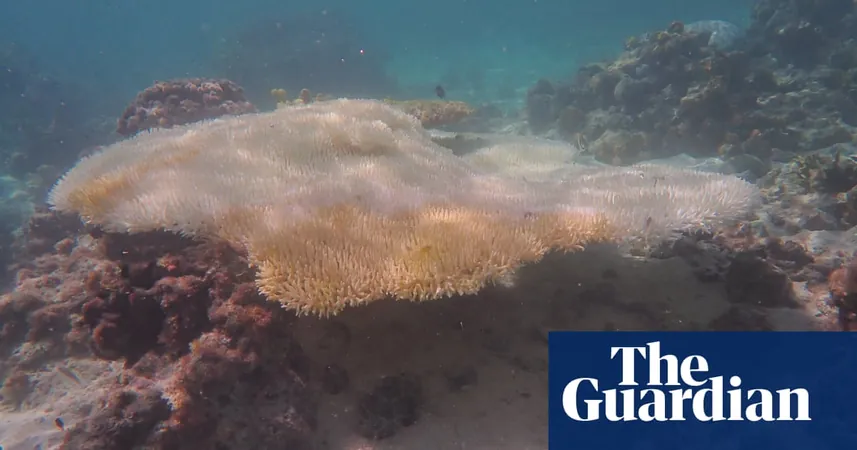
Devastation in Paradise: Great Barrier Reef Faces Unprecedented Coral Bleaching Crisis!
2025-01-21
Author: John Tan
Coral Bleaching Crisis in the Great Barrier Reef
A shocking new study reveals that last year, more than 40% of coral colonies around One Tree Island, situated in the southern part of the Great Barrier Reef, were killed in what researchers are calling the most extensive coral bleaching event ever recorded. As scientists monitored 462 coral colonies, they were met with “catastrophic” scenes; by July, the findings confirmed that 193 coral colonies had died, and an additional 113 were still showing signs of bleaching.
Expert Insights
Professor Maria Byrne, a leading marine biologist from the University of Sydney, has dedicated 35 years to studying this fragile ecosystem, and stated, "Witnessing the death of these massive coral colonies has been utterly devastating. Our warnings about climate change seem to fall on deaf ears."
Drop in Coral Cover
This bleak report follows findings from the Australian Institute of Marine Science (AIMS), which documented the largest annual decline in hard coral cover since monitoring began in the mid-1980s, with a staggering 41% drop in the Capricorn-Bunker sector. In some areas of the northern reef, the bleak outlook is confirmed by one scientist’s grim description of a "graveyard of corals."
Monitoring Coral Health
The researchers employed advanced methods, including temperature loggers and video observations, to track the health of 12 different coral species. They noted an alarming misconception in popular belief: “While corals can sometimes bounce back from mild bleaching given cooler waters, what we observed at One Tree Reef was unequivocally catastrophic,” they stated in their report.
Vulnerability of Goniopora
One particularly vulnerable genus, Goniopora, known for its vibrant flower-like appearance, was not only bleached but also showed signs of being afflicted with a flesh-eating disease known as black band. This emphasizes the desperate state of marine life in the region.
The State of Coral Colonies
Dr. Shawna Foo, a co-author of the study, echoed these sentiments, explaining, “After just five months of monitoring, many colonies were barely recognizable, buried under algae, dead, or simply crumbling.”
Temperature Concerns
Typically, March marks the peak stress period for the reef, and this year has been no exception. According to the Great Barrier Reef Marine Park Authority, temperatures have soared up to 1.2°C above average, putting the corals under extreme pressure. The USA’s Coral Reef Watch program has warned that areas north of Cooktown may face additional heat stress, raising fears of even more widespread bleaching by mid-February.
Urgency of Action
Richard Leck, head of oceans at WWF-Australia, highlighted the urgency of the situation: “We have yet to gather all the data from last summer’s bleaching, but it’s clear that significant coral mortality has occurred from north to south. As heat stress increases, especially in the northern parts of the reef, we could be on the brink of successive bleaching events. It truly is a game of Russian roulette.”
Government Response Required
The Australian government is under pressure from UNESCO to deliver a comprehensive report on the reef’s health by early next month. Leck remarked, “It is imperative that an accurate representation of the reef's status is made, and that new and escalated efforts to protect this UNESCO World Heritage site arise from this grim reality.”
Call to Action
The clock is ticking for the Great Barrier Reef, and as the world watches, urgent action is needed to mitigate the impact of climate change and restore this natural wonder before it’s too late.


 Brasil (PT)
Brasil (PT)
 Canada (EN)
Canada (EN)
 Chile (ES)
Chile (ES)
 Česko (CS)
Česko (CS)
 대한민국 (KO)
대한민국 (KO)
 España (ES)
España (ES)
 France (FR)
France (FR)
 Hong Kong (EN)
Hong Kong (EN)
 Italia (IT)
Italia (IT)
 日本 (JA)
日本 (JA)
 Magyarország (HU)
Magyarország (HU)
 Norge (NO)
Norge (NO)
 Polska (PL)
Polska (PL)
 Schweiz (DE)
Schweiz (DE)
 Singapore (EN)
Singapore (EN)
 Sverige (SV)
Sverige (SV)
 Suomi (FI)
Suomi (FI)
 Türkiye (TR)
Türkiye (TR)
 الإمارات العربية المتحدة (AR)
الإمارات العربية المتحدة (AR)